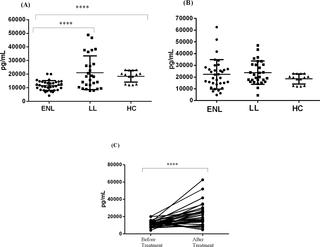PLOS Neglected Tropical Diseases ( IF 3.4 ) Pub Date : 2018-03-02 , DOI: 10.1371/journal.pntd.0006321 Edessa Negera , Stephen L. Walker , Tsehaynesh Lema , Abraham Aseffa , Diana N. Lockwood , Hazel M. Dockrell

|
Complement C1q is a soluble protein capable of initiating components of the classical pathway in host defence system. In earlier qualitative studies, C1q has been implicated in the pathogenesis of Erythema Nodosum Leprosum (ENL). However, little is known about the role of this complement in ENL reaction. In the present study we described the protein level of C1q production and its gene expression in the peripheral blood and skin biopsies in patients with ENL reaction and lepromatous leprosy (LL) patient controls before and after treatment. Thirty untreated patients with ENL reaction and 30 non-reactional LL patient controls were recruited at ALERT Hospital, Ethiopia. Peripheral blood and skin biopsies were obtained from each patient before and after treatment. The level of circulating C1q in the plasma was determined by enzyme-linked immunosorbent assay. The mRNA expression of the three C1q components, C1qA, C1qB, and C1qC in the peripheral blood and skin biopsies was determined by qPCR. Circulating C1q in the peripheral blood of untreated ENL patients was significantly decreased compared to LL patient controls. Untreated ENL patients had increased C1q gene expression in the peripheral blood compared to LL controls. Similarly, C1qA and C1qC gene expression were substantially increased in the skin biopsies of untreated ENL patients compared to LL controls. However, after treatment none of these genes show significant difference in both groups. In conclusion, while circulating C1q is inversely correlated with active ENL reactions, its gene expression is directly correlated with ENL. The decreased circulating C1q may suggest the utilization of C1q in immune-complex formation in these patients. Therefore, C1q could be a potential diagnostic marker for active ENL reactions as well as for monitoring ENL treatment.
中文翻译:

结节性麻风中补充C1q表达
补体C1q是一种可溶性蛋白质,能够启动宿主防御系统中经典途径的成分。在较早的定性研究中,C1q与红斑结节性麻风病(ENL)的发病机理有关。然而,关于这种补体在ENL反应中的作用知之甚少。在本研究中,我们描述了治疗前后ENL反应患者和麻风麻风病患者(LL)患者外周血和皮肤活检中C1q产生的蛋白质水平及其基因表达。在埃塞俄比亚的ALERT医院招募了30名未经治疗的ENL反应患者和30名非反应性LL患者对照。在治疗之前和之后从每位患者获得外周血和皮肤活检。通过酶联免疫吸附测定法测定血浆中循环C1q的水平。通过qPCR确定三种C1q成分C1qA,C1qB和C1qC在外周血和皮肤活检组织中的mRNA表达。与LL患者对照相比,未经治疗的ENL患者外周血中的循环C1q显着降低。与LL对照相比,未经治疗的ENL患者外周血C1q基因表达增加。类似地,与LL对照相比,未经治疗的ENL患者的皮肤活检中C1qA和C1qC基因表达显着增加。然而,治疗后,这些基因在两组中均未显示出显着差异。总之,尽管循环中的C1q与活跃的ENL反应成反比,但其基因表达却与ENL直接成正比。循环C1q降低可能提示这些患者在免疫复合物形成中使用了C1q。因此,C1q可能是活跃的ENL反应以及监测ENL治疗的潜在诊断标记。










































 京公网安备 11010802027423号
京公网安备 11010802027423号